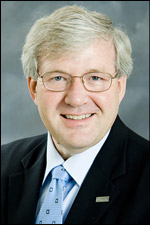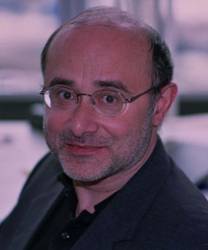Workshop Program
Invited Speakers
Prof. Roger L. King, Mississippi State University, Department of Electrical and Computer Engineering, Mississippi State, MS, USA
Title: Earth Understanding from Observation: A Contextual Approach
Abstract: The ultimate goal of any Earth Observation (EO) system is to provide understanding. However, this understanding will often require expertise and/or data sources from globally distributed resources and will present some unique challenges for the local remote sensing analyst. For example, how do I bring together geospatially diverse resources to facilitate sharing and knowledge discovery? How do I mine data from a variety of sources (sensors, databases, images) and create information products and actionable intelligence? This is further complicated when it is recognized that decisions from EO data are most often needed for making local decisions. In other words, how can EO (satellite remote sensing) imagery be used in instantiating a variety of physical process models and be used in assessing impacts on geopolitical and socioeconomic factors at a scale that impacts me where I live?
This presentation will lay out a Grand Challenge for those engineers and scientists involved in pattern recognition in the Earth remote sensing arena. This presentation describes the problem space for making local decisions and introduces the concept of contextual remote sensing. The presentation asks for an answer to the question of how do we merge high resolution geophysics and geoinformation, in the right local context, to enable local decision making for socioeconomic benefit? For example, a solution based on EO imagery may be different in the United States, than for one in Turkey based upon local cultural and socioeconomic factors. Answers will require addressing the multi-dimensional aspects of the EO imagery – hyper-spatial, hyper–spectral, hyper-temporal, and hyper-sensors. Also, due to the unique requirements of these datasets a new challenge of interoperability of language will be introduced. This challenge will deal with both semantics and semiotics in the context of EO imagery. This interoperability of language is going to be an important factor in dealing with contextual remote sensing.
 Biography: Dr. Roger Lee King is Director of the Center for Advanced Vehicular Systems (CAVS) and a Giles Distinguished Professor at the Mississippi State University. King received his BS in electrical engineering from West Virginia University in 1973, a MS in electrical engineering from the University of Pittsburgh in 1977, and a doctorate from the University of Wales in the United Kingdom in 1988.
Biography: Dr. Roger Lee King is Director of the Center for Advanced Vehicular Systems (CAVS) and a Giles Distinguished Professor at the Mississippi State University. King received his BS in electrical engineering from West Virginia University in 1973, a MS in electrical engineering from the University of Pittsburgh in 1977, and a doctorate from the University of Wales in the United Kingdom in 1988.
As the Director of CAVS, King is responsible for an interdisciplinary research center comprised of engineering, research, development, and technology transfer teams focused on enhancing human and payload mobility. The CAVS activities are clustered around material science, manufacturing process modeling, computational mechanics, computational fluid dynamics, multi-scale modeling, vehicular systems engineering, design optimization, human factors and ergonomics, alternative powered systems, and intelligent electronic systems. Research activities include efforts on vehicle weight reduction, improved crashworthiness, crash avoidance, new power generation, autonomous vehicle control (robotics) as well as advances in improved diagnostics, manufacturing, human interface, and computational design technologies.
King has served as the Associate Dean for Research and Graduate Studies for the Bagley College of Engineering; Director of the National Consortium on Remote Sensing in Transportation: Environmental Assessments; Coordinator of International Programs in the College of Engineering; Director of Computational Geospatial Technologies Center, Engineering Research Center; and Interim Director for the Institute for Clean Energy Technology (formerly Diagnostic Instrumentation and Analysis Laboratory). King also served as Chief Technologist for NASA Headquarters Earth Science Applications for one year in Washington, D.C. in an Intergovernmental Personnel Assignment, a senior technical and policy position that provided unique insight into the executive and legislative branches of government. He has authored over 200 publications and book chapters, served on editorial boards of journals, and holds 4 patents.
Dr. Giovanni Marchisio, DigitalGlobe Inc., Research & Development, Longmont, CO, USA
Title: Quantifying Spectral Predictor Value in High Resolution WorldView-2 Imagery
Abstract: WorldView-2, launched on October 8, 2009, is the first commercial satellite to carry a high resolution 8-band multispectral sensor. The WV110 focal plane carried by WorldView-2 has a total of one panchromatic band with 50cm pixel resolution and eight multispectral bands with 2.0m resolution. The eight bands are C=Coastal Blue, B=Blue, G=Green, Y=Yellow, R=Red, RE=Red Edge, NIR1, and NIR2, with center wavelengths at 425, 480, 545, 605, 660, 725, 835, and 950 nm respectively.
We have undertaken a comparative land cover classification study with some of the first WorldView-2 imagery from over 50 sites around the world. Our aim is: 1) to assess the incremental improvement in land cover classification accuracy attributable to the new spectral bands and 2) to generate an atlas detailing the relative predictive power of the WorldView-2 spectrum for resolving selected land cover types. Methods employed for comparative predictor assessment include classification trees and tree ensembles, logistic regression, non-linear regression models, support vector machines, neural networks and Bayesian classifiers. Applied problem areas encompass plant species and crop identification, bug infestation, mapping of vegetation phenomenology, crop stress, forest fires, bathymetry, benthic habitat mapping, coast water quality, mapping of wetlands, and improved discrimination between basic spectral end members such as water and shadow.
Landsat-like spectral coverage at the 2m pixel resolution level provides the basis for more accurate descriptors of image content and a more sophisticated framework for image mining. As we begin to extend the notion of a visual grammar previously developed for lower resolution imagery to WorldView-2 imagery, we find that old paradigms no longer apply. For instance, we are experimenting with new spectral descriptors that rely on the topology of ensemble classifiers instead than on the notion of spectral mixtures. Also, at high resolution scales, new geometric attributes are an important complement to more traditional textural, morphological and spectral features. We will briefly explain how this fits in with our long term strategy for mining information in our repository of remotely sensed images, which is currently the largest commercial library in the world.
 Biography: Giovanni Marchisio is currently a Principal Scientist at DigitalGlobe Image where he is developing scalable image mining algorithms and data structures to test the limits of what is possible on the largest commercial high resolution satellite image library in the world. Prior to that, he worked for thirteen years for Insightful/Mathsoft, a world leader in statistical data mining and the maker of S-PLUS, most recently as CTO, VP of R&D, VP of Engineering, and founder of their division for text and multimedia data mining. During that time he was also a PI on several R&D projects with DARPA, NASA, USAF and the NIH, and led a 7 year project in satellite image mining with NASA’s Goddard Space Flight Center. Dr. Marchisio has articulated novel ideas and software architectures in the areas of multimedia retrieval, multispectral satellite image mining, video mining, search engines, computational linguistics, microarray analysis and functional genomics. He is the author or co-author of several papers, book chapters, the primary inventor on eight recent US patents, and was an invited speaker at the US House of representatives in April 2001. He also served as a visiting professor with the Department of Geophysics and Astronomy at the University of British Columbia. He holds a B.A.Sc. in Engineering from the University of British Columbia, Vancouver, Canada, and a Ph.D. in Geophysics and Planetary Physics from the University of California, San Diego (Scripps Institute).
Biography: Giovanni Marchisio is currently a Principal Scientist at DigitalGlobe Image where he is developing scalable image mining algorithms and data structures to test the limits of what is possible on the largest commercial high resolution satellite image library in the world. Prior to that, he worked for thirteen years for Insightful/Mathsoft, a world leader in statistical data mining and the maker of S-PLUS, most recently as CTO, VP of R&D, VP of Engineering, and founder of their division for text and multimedia data mining. During that time he was also a PI on several R&D projects with DARPA, NASA, USAF and the NIH, and led a 7 year project in satellite image mining with NASA’s Goddard Space Flight Center. Dr. Marchisio has articulated novel ideas and software architectures in the areas of multimedia retrieval, multispectral satellite image mining, video mining, search engines, computational linguistics, microarray analysis and functional genomics. He is the author or co-author of several papers, book chapters, the primary inventor on eight recent US patents, and was an invited speaker at the US House of representatives in April 2001. He also served as a visiting professor with the Department of Geophysics and Astronomy at the University of British Columbia. He holds a B.A.Sc. in Engineering from the University of British Columbia, Vancouver, Canada, and a Ph.D. in Geophysics and Planetary Physics from the University of California, San Diego (Scripps Institute).
